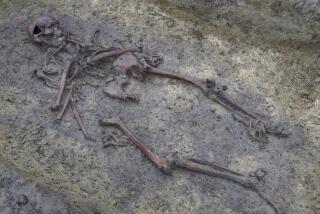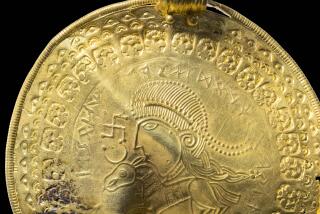Vikings Hooligans Abroad, Mild at Home
- Share via
BIRKA, Sweden — Away from home, the Vikings had a reputation as the world’s first international hooligans--savage, uncouth, thirsting for a drink and a fight.
Back in Scandinavia, they were considered good family men who respected their women and led quietly industrious lives, with a taste for imported pottery and soft feather bedding.
“The Vikings had a peaceful sub-structure in Scandinavia but were warlike abroad,” said Bjorn Ambrosiani, project director of a five-year excavation which has just begun at Birka in the Malaren valley 18 miles west of Stockholm.
Archeological discoveries in the last 150 years have steadily transformed the Viking’s image from that of heroic warrior to peaceful trader.
Ambrosiani’s dig at Birka on the idyllic island of Bjorko, the largest Viking excavation of its kind, seems sure to strengthen the idea of a civilized Viking living in harmony with his neighbors and with nature.
The daily Dagens Nyheter, reviewing a Viking exhibition in Malmo, said the Viking was ready to join the European Community (EC).
“This year’s image is of a cultivated trader and city dweller with international contacts, rather than a rough bearded fellow looking for a drink and a fight. He is a family man compatible with the EC,” it said.
But memories of blood and thunder remain. Reading the rune-stones scattered round the shores of the Malaren valley, a visitor senses the terror that an approaching Viking longboat must have caused their victims.
“They traveled bravely and far and in the east gave food to the eagles,” a euphemism for slaughter, the stone outside Gripsholm castle says.
Mats Larsson, author of a new book about Ingvar the Wayfarer’s travels, said at least 10% of the Malaren valley’s inhabitants traveled abroad in search of honor and fortune, often as mercenaries.
Ironically, Christian missionaries were arriving at Birka around the same time as Vikings from present-day Denmark and Norway were sacking the monastery of Lindisfarne in northeast England in AD 793.
A Celtic cross on the weather-smoothed granite of Birka, commemorating the first visit by the German monk Ansgar in 829, rises above the 2,000 burial mounds that make this the largest funeral site in Scandinavia.
Silver pendants in the form of crosses have been found in some graves, suggesting that their owners were Christians. But other burial mounds contained hammers and iron neck-rings dedicated to the pagan god Thor.
The struggle between Christianity and paganism ebbed and flowed on Birka. The islanders responded to Ansgar but soon tired of his successor Gautbert’s preaching and chased him away.
Birka, the cardinal point where Swedish urban life, industry and trade began, attracts thousands of day-trippers aboard modern ferries from Stockholm.
Ambrosiani said archeologists from Sweden, Britain, Denmark and the Soviet Union had in the first three months of digging unearthed bones, beads and other material from Birka’s golden age between about AD 800 and 970.
Birka was perfectly positioned on trade routes between Europe via Sodertalje to the south and the Viking towns of Sigtuna and Uppsala to the north and had easy access to the eastern routes via Stockholm.
In its heyday, Birka was a gigantic storehouse, collecting iron, furs, elk antlers and duck down over the winter months and exchanging them for foreign luxury goods when the waterways became passable in spring.
“They had winter markets on the ice. Some of the graves contain ice skates made out of animal bones,” said Neil Price, a postgraduate student of York University in England. He has been working at Birka.
The Malaren Vikings’ forays to the east took them through the Russian river system to the Caspian Sea and Black Sea, and they brought back silk, salt, swords and slaves. “Birka declined when boats became too big to drag over land,” said Ambrosiani.
More to Read
Sign up for Essential California
The most important California stories and recommendations in your inbox every morning.
You may occasionally receive promotional content from the Los Angeles Times.










